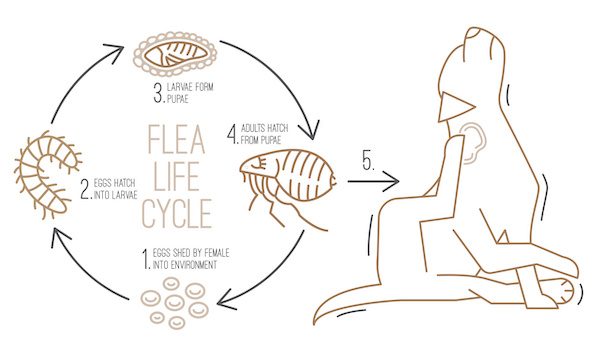As pet owners, the last thing we want is our furry friends dealing with pesky flea infestations. Ever wondered about those tiny flea eggs on dogs and how to tackle them effectively? Well, you’re in the right place!
In this guide, we’re breaking down everything you need to know—from what these microscopic eggs are to where they like to hide. Let’s dive into the practical side of dealing with flea eggs and keeping your four-legged pals itch-free.
Where Do Flea Eggs Hide?
Adult female fleas strategically deposit eggs in clusters, a calculated move aimed at boosting survival rates and ensuring a consistent cycle of fleas. These deliberate actions lay the foundation for the generations to come.

Flea eggs find a covert refuge nestled discreetly within the fibers of your carpets. The warmth and coziness of these floor coverings provide an ideal environment for eggs to mature and hatch into larvae.
Your pet’s preferred resting spots, whether a plush bed or a cozy blanket, may also unknowingly become hideouts for flea eggs. These minuscule menaces lurk in the folds and crevices, patiently awaiting the right conditions to transform into potential nuisances.
Even the cracks in various types of flooring – be it hardwood, laminate, or tile – serve as silent incubators for flea eggs. These tiny crevices act as ideal hiding spots, allowing eggs to remain undisturbed until they hatch and continue the infestation.
Finding Flea Eggs on Dogs
Finding flea eggs on dogs demands a watchful eye and a bit of know-how. Flea eggs sport a pearly white hue, and they’re tiny – about 0.5 mm. Their discreet size often challenges even the most attentive pet parents.
Unlike the texture of dandruff or general debris, flea eggs feel smooth and slightly shiny. A gentle run through your pet’s fur can help you differentiate between ordinary particles and potential flea eggs.
White Towel Test
Lay out a white towel on a flat surface. White provides a stark contrast, making it easier to spot flea dirt and any of the tiny, light-colored flea eggs.
Using a flea comb, focus on areas where fleas commonly hide, like around their neck, back, and tail. This helps to dislodge flea eggs, fleas, or flea dirt (flea feces) clinging to your pet’s fur.
After the brushing session, carefully examine the white towel. Look for tiny, oval-shaped specks or small, dark particles that resemble ground black pepper on the white towel.
If you spot any of these, there’s a good chance your pet may suffer from flea infestation.
Visual Cues
Flea infestations often manifest through noticeable behavior changes in pets, primarily marked by intensified itching. If your furry companion is consistently scratching, particularly around the neck and tail areas, it could be an early indication of a silent invasion by fleas.
The relentless biting by fleas doesn’t just cause itching but can also result in discomfort and restlessness in your pet. Should your dog display unusual fidgetiness or agitation, it might be a subtle sign pointing toward ongoing flea activity.

Look for any shifts in their fur, such as the development of bald patches or alterations in overall hair condition. Fleas have the potential to contribute to hair loss, making these observations crucial for the timely identification of potential flea issues.
Trusting the Expert Eye
If you’re still unsure, contact your veterinarian!
These professionals bring a wealth of expertise to the table, conducting meticulous examinations to find flea eggs on dogs. Their in-depth knowledge allows them to provide personalized prevention and treatment recommendations.
Battling Fleas on Your Pet and in Your Home
The battle against fleas extends beyond your four-legged friend’s fur; it encompasses the very spaces where they play, rest, and explore.
Incorporating regular grooming sessions for your pet holds significance beyond aesthetics. It is pivotal in removing flea eggs and disrupting the entire flea life cycle. By paying particular attention to areas where fleas commonly hide, such as the base of their tail and behind their ears, you enhance the effectiveness of your efforts.
Addressing potential hiding spots for flea eggs within your home is equally vital. Engaging in routine vacuuming, laundering bedding, and conducting thorough floor cleaning contribute to eliminating eggs, larvae, and adult fleas. This proactive approach curtails their ability to thrive in your living environment.
Consider bolstering your defense by incorporating flea preventatives recommended by your veterinarian into your arsenal. These preventatives come in various forms, including topical treatments, oral medications, or flea collars.
However, trusting the professionals here at United States Pest Service is the best move to eliminate fleas for good! Our comprehensive approach isn’t just about removing pests; it’s about safeguarding the well-being of your beloved pets, sparing them from the discomfort and itch associated with flea infestations.
For flea infestations in Orange or Rockland counties, contact us!

